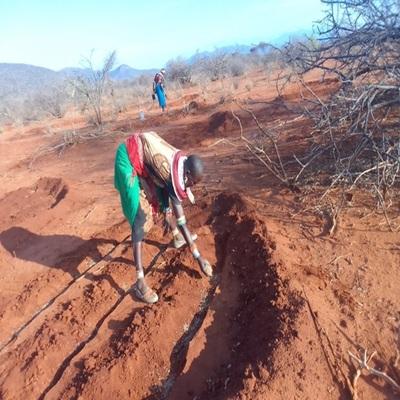Rangelands Management
The Conservancy Rangeland management involves deliberate manipulation of grazing animal distribution, density, and timing to achieve sustainable resource products.
Vegetation monitoring is conducted regularly and fed in Vegetation Conservancy Monitoring and Management System (vegCoMMS).
When there is good pasture, livestock bunching would be conducted of at least 3,000 steers overseen by professional veterinary officers from Northern Rangelands Trust - Trading (NRT-T) for fattening and when ready in about 3 months, they are ready for market at the will of owners. The cattle's presence in the landscape leaves their deposit of cow dung that acts as manure and their hooves dig the ground making it percolative of rain surface water hence dissipating in the ground and causing water to be retained in the ground good for germination of fresh grass.
Grazing plans are made by the Grazing Committee splitting the Buffer Area in wet and dry season grazing blocs. The committee is supported by Village Based Committees (VBCs) in the villages to plan and disseminate grazing plans information for sustainable rangelands management.
Rehabilitation of the landscape is conducted by clearing invasive species like the Acacia Reficiens, mitigating soil erosion and grass reseeding ahead of the rains.
Activities
Moran Engagement
Since Kalama is always in the center of other conservancies geographically, there is a lot of livestock passing by the conservation area. Most livestock comes from the neighbouring conservancies from as far as Baragoi. The grazing committee takes the initiative to have a dialogue with the morans.
Village Based Committee Engagement
The members of Village based grazing committee from all zones has highlighted how they have been able to achieve their set-out plans despites some challenges with their neighbouring zones.
Soil Erosion Control
Fifty community members to create semi-circular bands to control soil erosion. 1014 semi-circular bands were formed.
Herders Engagement
We managed to engage herders in Nakwamoru village to curb encroachment around sarova and its environs. This was mainly done to reduce pressure in all protected areas.
Herdes Training
Herders were trained to equip them with basic knowledge on: -
- Livestock diseases
- Pasture production
- Animal husbandry
- Rangelands management
Grazing Committee Refresher Training
Grazing Committee refresher training is conducted courtesy of Grevy’s Zebra Trust (GZT), to remind the team of basic principles of rangeland and livestock management. The team agrees to take home and implement the skills required.
Settlements Realignment
The Grazing Committee team with support from the Area Chief and other local administrators regularly flush settlements out of community grazing blocks to ease grazing plan implementation and this has been successfully achieved.
Awareness Meetings
This is normally done to sensitize the community on the importance of soil erosion control measures and natural resources management.
Livestock Control in Core Area

Reseeding Exercise

Acacia Reficiens Clearing
Grazing Committee Meetings








